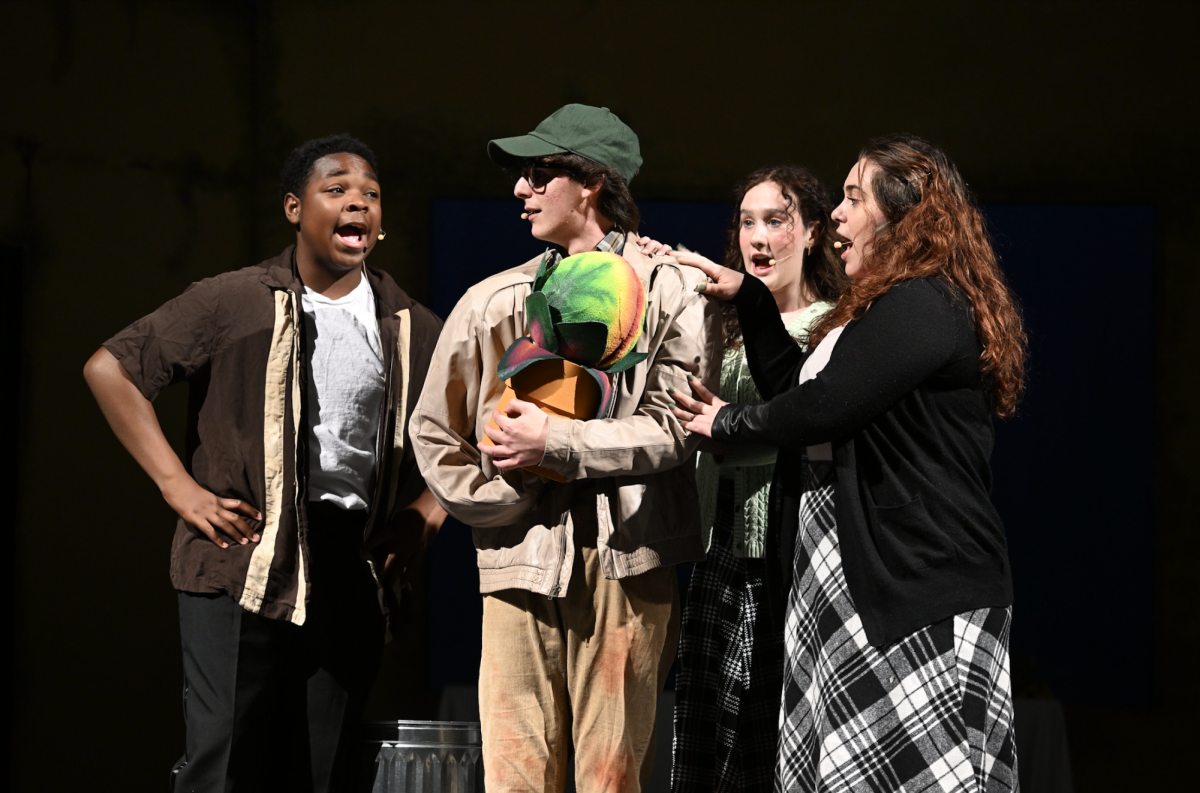Under flickering lights and the perpetual haze of urban grime, Skid Row comes alive–a place where dreams decay as quickly as discarded newspapers on cracked sidewalks. Hope is scarce, and strange things bloom in the shadows. From the first haunting note to the cautionary tale’s finale, Wakefield High School’s production plunges into the surreal corner of downtown despair as you enter the Little Shop of Horrors.
Where doo-wop harmonies echo through the streets and danger lurks in a flowerpot, Little Shop follows Seymour Krelbourn, the clumsy florist who stumbles upon a mysterious, flesh-eating plant with a taste for trouble. The plant, named Audrey II after the sweet and spacey Audrey whom Seymour pines for, grows bigger, bolder, and downright bloodthirsty. Seymour is swept into a whirlwind of fame, fortune, and fantastically freaky consequences. The dark comedy was originally brought to life in 1960 with a low-budget film directed by Roger Corman. It became a cult sensation in 1982 when Disney composers Alan Menken and Howard Ashman transformed it into an inventive off-Broadway musical, blending campy horror with catchy 1960s-style rock.
Tripping into the show with moral dilemmas and a wonderfully awkward charm, August Carr as Seymour Krelbourn carried themself with an endearing nervousness and a heart full of dreams. Executing Seymour’s fast-spitting lines with an authentic working-class New York accent, Carr maintained crisp enunciation in tandem with Seymour’s stammering personality. Blending emotional vulnerability and comedic tension, Carr’s portrayal of Seymour’s dweeb through tenor vocals paired excellently in duets with the lovably naive Audrey (Ava Spera) and scheming flower shop owner Mushnik (Nico Krug Weinberg). Whether fumbling with flower pots or melting under Audrey’s gaze, Carr grounded the show’s outrageous plot with a human heart.
Growing into the show-stealing, charismatic plant, Audrey II, voiced by Xavier Dent, exuded a sinister charm that was both seductive and monstrous. Dripping with sass and confidence, Dent let his deep baritone growl with smooth-talking swagger. His ad-libbed gestures added both menace and vaudeville humor to the bloodthirsty plant. Slipping on a pair of devious sunglasses, Dent readied the audience for the manipulative stage domination of Audrey II.
Blooming like wildflowers in the cracked concrete of Skid Row, the Urchins Ronnette (Angelina Kaminsky), Crystal (Clarence Martin), and Chiffon (Dylan Meyers) acted as the chaotic, mischievous Greek chorus. Belting out soulful harmonies that narrated the show, the trio spoke louder through synchronized body language. Popped hips, raised eyebrows, and playful smirks punctuated every song with sass. Their infectious energy and playful cynicism brought comic relief and the show’s heartbeat
Emphasizing the urban decay and moral tension, the lighting design by Sean Glaze, Ike Mandaville, and Ella Sitz played a crucial role in shaping the story. A soft pink hue underscored the swooning moments between Seymour and Audrey, while deep, eerie reds drenched the stage in scenes of mounting danger. A simple wash, bathed with unease, transformed into cleaner tones as the theme of wealth and greed cleaned up the shop.
The production would be incomplete without its puppeted Audrey II plants. Thanks to the combined efforts of the Set teams (Niko Godoy, Ethan Myers, Isaac Souryal, and the Wakefield Set Crew), and Props teams (August Carr, Caleb Hayes, Teddy Seylar, August Yates), the escalating size and design of the puppet reflected the plant’s growing menace. Each new reveal brought an unsettling foreshadowing of evil around the corner.
Wrapped in playful tunes and floral designs, Wakefield High School’s production doesn’t hesitate to delve into themes of temptation and greed. Bright blooms can be deceiving- what seems full of promise may be rooted in something far more unsettling.



